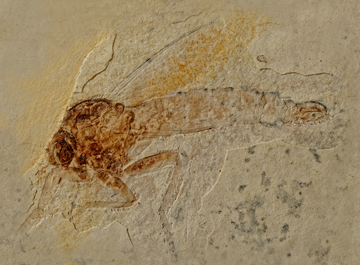Abstract
The Fossil-Lagerstätte of Grube Messel, Germany, has produced some of the most spectacular fossils of the Paleogene (Schaal & Ziegler, 1992; Gruber & Micklich, 2007; Selden & Nudds, 2012; Schaal et al., 2018). However, few arachnids have been discovered or described from this World Heritage Site. An araneid spider was reported by Wunderlich (1986). Wedmann (2018) reported that 160 spider specimens were known from Messel although, sadly, few are well preserved. She figured the araneid mentioned by Wunderlich (1986) and a nicely preserved hersiliid (Wedmann, 2018: figs 7.8–7.9, respectively). Wedmann (2018) mentioned six opilionids yet to be described, and figured one (Wedmann, 2018: fig. 7.10). Here, we report a new, well preserved spider, Lutetiana neli gen. et sp. nov., the first to be formally described from the locality, which is placed in the Marronoidea (the Marronoid Clade of Wheeler et al., 2017), and possibly in the family Cybaeidae.
References
Ackermann, M., Habersetzer, J. & Schaarschmidt, F. (1992) From excavation to exhibition piece. In: Schaal S. & Ziegler, W. (Eds.), Messel. An insight into the history of life and of the earth. Clarendon Press, Oxford, pp. 277–284.
Bertkau, P. (1878) Einige Spinnen und ein Myriapode aus der Braunkohle von Rott. Verhandlungen des Naturhistorischen Vereins der Preussischen Rheinlande und Westfalens, Bonn, 35, 346–360, pl. 5.
Briggs, D.E.G., Stankiewicz, B.A., Meischner, D., Bierstedt, A. & Evershed, R.P. (1998) Taphonomy of Arthropod Cuticles from Pliocene Lake Sediments, Willershausen, Germany. Palaios, 13, 386–394.
https://doi.org/10.2307/3515326
Downen, M.R., Selden, P.A. & Hasiotis, S.T. (2016) Spider leg flexure as an indicator for estimating salinity in lacustrine paleoenvironments. Palaeogeography, Palaeoclimatology, Palaeoecology, 445, 115–123.
https://doi.org/10.1016/j.palaeo.2015.11.028
Dunlop, J. A., Penney, D. & Jekel, D. (2019) A summary list of fossil spiders and their relatives. In: World spider catalog, version 20.0. Natural History Museum, Bern. Available at http://wsc.nmbe.ch
Felder, M. & Harms, F.-J. (2004) Lithologie und genetische Interpretation der vulkano-sedimentären Ablagerungen aus der Grube Messel anhand der Forschungsbohrung Messel 2001 und weiterer Bohrungen. Courier Forschungsinstitut Senckenberg, 252, 151–203.
Gruber, G. & Micklich, N. (Eds.) (2007) Messel: treasures of the Eocene. Hessisches Landesmuseum Darmstadt, Darmstadt, 159 pp.
Harms, F.-J., Nix, T. & Felder, M. (2003) Neue Darstellungen zur Geologie des Olschiefer-Vorkommens Grube Messel. Natur und Museum, 132, 137–149.
Heer, O. (1865) Die Urwelt der Schweiz. Friedrich Schultheß, Zürich, xxix + 622 pp.
Heyden, C. von. (1859) Fossile Insekten aus der Rheinischen Braunkohle. Palaeontographica, 8, 1–15, pl. 1.
Jocqué, R. & Alderweireldt, M. (2006) Lycosidae: the grassland spiders. Acta Zoologica Bulgarica, Supplement, 1, 125–130.
Lenz, O.K., Wilde, V., Mertz, D.F. & Riegel, W. (2015) New palynology-based astronomical and revised 40Ar/39Ar ages for the Eocene maar lake of Messel (Germany). International Journal of Earth Sciences, 104, 873–889.
https://doi.org/10.1007/s00531-014-1126-2
Lutz, H., Neuffer, F.O., Harms, F.-J., Schaal, S., Micklich, N., Gruber, G., Schweigert, G. & Lorenz, V. (2000) Tertiäre Maare als Fossillagerstätten: Eckfeld, Messel, Randeck, Höwenegg, Öhningen. Mainzer Naturwissenschaftliches Archiv, Beihefte, 24, 125–160.
Mertz, D.F. & Renne, P.R. (2005) A numerical age for the Messel fossil deposit (UNESCO World Heritage Site) derived from 40Ar/39Ar dating on a basaltic rock fragment. Courier Forschungsinstitut Senckenberg, 255, 67–75.
Moya-Laraño, J., Vinković, D., De Mas, E., Corcobado, G., & Moreno, E. (2008) Morphological evolution of spiders predicted by pendulum mechanics. PLOS ONE, 3, e1841.
https://doi.org/10.1371/journal.pone.0001841
Roth, V.D. (1993) Spider genera of North America. Third edition. Published by the author, Portal, Arizona, 203 pp.
Schaal, S.F.K., Smith, K.T. & Habersetzer, J. (2018) Messel-Ein fossiles Tropenökosystem. Schweizerbart, Stuttgart, 355 pp.
Schaal, S. & Ziegler, W. (1992) Messel. An insight into the history of life and of the Earth. Clarendon Press, Oxford, 322 pp.
Schaber, C.F. & Barth, F.G. (2015) Spider joint hair sensilla: adaptation to proprioreceptive stimulation. Journal of Comparative Physiology A, 201, 235–248.
https://doi.org/10.1007/s00359-014-0965-4
Schawaller, W. (1982) Zur fossilen Spinnenfauna des Pliozäns von Willershausen in Norddeutschland (Arachnida, Araneae). Berichte der Naturhistorischen Gesellschaft zu Hannover, 125, 89–95.
Schawaller, W. & Ono, H. (1979) Fossile Spinnen aus miozänen Sedimenten des Randecker Maars in SW-Deutschland (Arachnida: Araneae). Jahreshefte der Gesellschaft für Naturkunde in Württemberg, 134, 131–141.
Selden P.A. & Nudds, J.R. (2012) Evolution of fossil ecosystems. Second edition. Manson, London, 288 pp.
https://doi.org/10.1201/b15128
Straus, A. (1967) Zur Paläontologie des Pliozäns von Willershausen. Berichte der Naturhistorischen Gesellschaft zu Hannover, 111, 15–24.
Wappler, T. & Engel, M.S. (2003) The Middle Eocene bee faunas of Eckfeld and Messel, Germany (Hymenoptera: Apoidea). Journal of Paleontology, 77, 908–921.
https://doi.org/10.1017/S0022336000044760
Wappler, T., Labandeira, C.C., Engel, M.S., Zetter, R. & Grimsson, F. (2015) Specialized and generalized pollen-collection strategies in an ancient bee lineage. Current Biology, 25, 3092–3098.
https://doi.org/10.1016/j.cub.2015.09.021
Wedmann, S., Poschmann, M. & Hörnschemeyer, T. (2009) Fossil insects from the Late Oligocene Enspel Lagerstätte and their palaeobiogeographic and palaeoclimatic significance. Palaeobiodiversity and Palaeoenvironments, 90, 49–58.
https://doi.org/10.1007/s12549-009-0013-5
Wheeler, W.C., Coddington, J.A., Crowley, L.M., Dimitrov, D., Goloboff, P.A., Griswold, C.E., Hormiga, G., Prendini, L., Ramírez, M.J., Sierwald, P., Almeida-Silva, L.M., Álvarez-Padilla, F., Arnedo, M.A., Benavides, L.R., Benjamin, S.P., Bond, J.E., Grismado, C.J., Hasan, E., Hedin, M., Izquierdo, M.A., Labarque, F.M., Ledford, J., Lopardo, L., Maddison, W.P., Miller, J.A., Piacentini, L.N., Platnick, N.I., Polotow, D., Silva-Dávila, D., Scharff, N., Szűts, T., Ubick, D., Vink, C., Wood, H.M. & Zhang, J.X. (2017) The spider tree of life: phylogeny of Araneae based on target-gene analyses from an extensive taxon sampling. Cladistics, 33, 576–616.
https://doi.org/10.1111/cla.12182
World Spider Catalog (2019) World spider catalog, version 20.5. Natural History Museum, Bern. Available at: http://wsc.nmbe.ch
Wunderlich, J. (1985) Ein bisher unbekannte fossile Krabbenspinne aus dem Randecker Maar in Südwest-Deutschland (Arachnida: Araneae: Thomisidae). Neue Entomologische Nachrichten, 14, 4–13.
Wunderlich, J. (1986) Die ersten Spinnen aus dem Mittel-Eozän der Grube Messel. Senckenbergiana Lethaea, 67, 171–176.
Wuttke, M., Uhl, D. & Schindler, T. (2010) The Fossil-Lagerstätte Enspel—exceptional preservation in an Upper Oligocene maar. Palaeobiodiversity and Palaeoenvironments, 90, 1–2.

